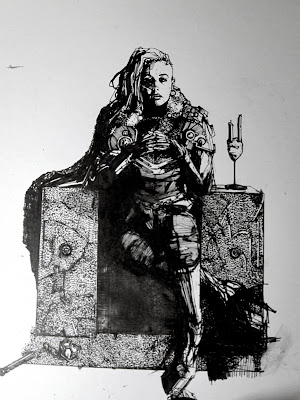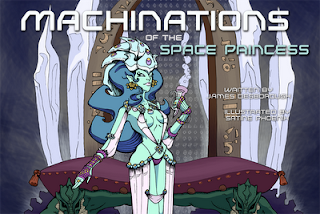So the company that makes D&D released
a video of their R&D team playtesting a game, with one Mr Mike Mearls GMing.
So what do we learn about the internal gamer culture at the company charged with keeping D&D alive from this?
First, and this is just about the video: they just play and make no attempt to entertain the internet audience and that's
really really nice. None of the cringey forced nerdjokery you get with some recorded games.
Second: This looks like a bunch of nice people playing D&D as I know it and not some jarringly skewed ivory tower gamewonk frenzy. While it isn't as chaotic as my average at-home game, it is quite recognizably in the ballpark of what I see when I log on to play a Google + game with some folks I've never played with before and have fun doing it.
Third: It is
obviously short on razzle and/or dazzle (no improvised props or lush descriptions, not too many voices, Mike Mearls announces the first real fight of the game at 1:32:12 with "two humanoid creatures leap off the edge and leap down upon you…" and that's that), though there are some good reasons for this:
- They're testing, so Mike's clearly trying to get them through a number of different kinds of situations relatively quickly
- This is a game where all the players already like D&D so much they made a career out of it. So Mike doesn't really need to "sell" them on the concept of a ghoul or an orc city. They know what those things are and are already engaged.
- With experienced players and a vanilla adventure (like, say, a tournament module you're playtesting with) sometimes dealing the cards fast and getting the hell out of the way so the players can just play is the best thing you can do.
...so there's probably people out there watching this thinking of all the things that their favorite GM does that Mike
doesn't, however what they
aren't noticing is how well he nails the underlying basics
that so many GMs miss.
So there's craft here, check it out...
-First and least obviously:
Pace.
This is the most important thing in GMing and it's done so well you don't notice: there's never a single moment of "Ummm, let me see here, ok..hold on....". I don't care if your adventure's got 9-dimensional jewel towers made of solid mutant algebra and random spell fumbles written by Phillip K Dick himself, if you don't have the basic dexterity to keep the game a
game every second of the hours we're playing, go practice.
-Info drip feed:
The beginning of this adventure has an investigation/reconnaissance element. For this kind of thing you want players to have as many puzzle pieces as possible (their plans will be more interesting the more information they have) but you also don't want to overwhelm them by backing the infodump truck up to the table edge.
Mearls controls this carefully: he gives the players
just enough information in his opening spiel, then gets out of their way so they can play D&D. Then when they ask questions, he thinks "Ok, what I said has sunk in and they want more" so he not only answers the questions but dribbles out a little extra information, too. This way he's slowly building a bigger understanding of the situation up from digestible chunks.
-Turning mechanics into useful details efficiently:
It would be easy to criticize Mike for just having the info-gathering players roll dice rather than role-play out the process and doing funny voices for all the city freaks who divulge useful lore or fail to, but remember: this is a playtest and even at
this pace without random NPCs giving out info via eerily accented roleplay, the party isn't fighting anything for real until about 3/4s of the way through the session. However, notice how Mike manages to give the players some texture even while treating the info-gathering sec
tion of the adventure as strictly preliminary. It might be short on entertainment value for us at home, but it gives the players the idea that taking the time to find out new stuff is worth it.
Like:
"Why don't you give me a wisdom check?"
James rolls a natural one. Mike still has information to feed out: the orcs s
eem tense. James gets something for putting out the effort to do reconnaissance.
James asks "Like they're expecting an attack?"
Mike: "No, like they don't trust each other."
This gives James one more thing to think about, which snaps into focus when James later deduces (well, infers, but induction is cool) from the ransacked orc that dopplegangers have been killing the orcs and stealing their clothes to get inside the complex.
Now you coulda gone another way with it: made the 1 a fumble and just told James some bullshit, (which is what I would've done--and I also would've rolled the check myself secretly) but the point is there is deliberate decision and method here, though it's subtle.
This is GMing: not always telling a thrilling tale of intrigue and romance, but standing on the edge of the swimming pool tossing in toys for the players to kick around-- "Here's this....and...here's this...and..."
(The actual kicking around process is hard to film. Thinking doesn't look like much on camera--that's why quiz shows always have a weird tracking shot set to music during Final Jeopardy or whatever.)
Note also how he uses what the player actually does to direct the story outcome of the die roll result in the Meatpie incident (below). Beginning GMs trying to figure out how charisma stat rolls and actual in-character persuasion attempts interact should take a look.
-Notice at 59:00 Mike chucks in an event--there's some kind of rumble going on off screen. Again, one more tool to play with. The players decline, but it's there. A lot of GMs get so tied in knots trying to follow what the PCs are up to they forget to keep the world rolling on behind them. More toys is good.
-Around 1:40:00 the ghoul tries to drag the cleric away to devour, rather than just keep slugging it out with the PCs. Good. That's what a ghoul would do. And if he'd made it back to the ghoul air that would've been fun. GMs who don't know what they're doing just have monsters show up and act like combat robots until the players die or they do.
-If the life of all those I hold dear depended on successful survival of a D&D adventure and I had to choose one WOTC staffer in this video to be in my party, I'd take Rodney Thompson (far right) no doubt. He asks smart questions (Wait, I thought this is a wretched hive of scum and villainy--there are murders? How is anyone even noticing?) he's proactive, he makes plans that keep the game moving, he thinks on his feet (inventing the "meatpie" gambit around 59:23 and saving everyone at least one encounter) and on top of all that he's metagame aware enough to help out the GM (noticing at 26:57 that Greg and Peter haven't gotten to do anything since Mike asked "Ok what's everybody doing?" ten minutes ago).
That is a sharp player. I want to take a look at everything this guy's ever written now. I also suspect his tattooed halfling with the sunken riverboat is a refugee from Warhammer's
Enemy Within campaign so he probably has good taste.
-Greg Bilsland (the one without the beard) is the other MVP here. How much worse would this video be to watch without Greg? Every party needs that player who can take it easy for all the sinners. "Oh, we're
fighting..." (42:06)
_
_
_





































